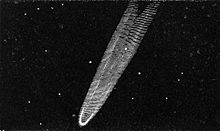Comet Tralles

Great Comet of 1819, from Uranography drawn by E. Otis Kendall (1850)
|
|
| Discovery | |
|---|---|
| Discovered by | Johann Georg Tralles |
| Discovery date | July 1, 1819 |
| Alternative designations |
1819 II, Great Comet of 1819 Comet Tralles |
| Orbital characteristics A | |
| Epoch | 2385614 |
| Perihelion | 0.341514 AU |
| Eccentricity | 1.00 |
| Inclination | 80.7517 |
| Last perihelion | June 28, 1819 |
The Great Comet of 1819, officially designated as C/1819 N1, also known as Comet Tralles, was an easily visible brilliant comet, approaching an apparent magnitude of 1–2, discovered July 1, 1819 by Johann Georg Tralles in Berlin, Germany. It was the first comet analyzed using polarimetry, by François Arago.
On July 1, 1819, Johann Georg Tralles in Berlin observed a brilliant comet low in the sky during the evening twilight. It was confirmed the next night by the astronomer Johann Elert Bode, also in Berlin.
On July 2, Tralles found the comet to have a coma of 40″. On July 3, Friedrich Georg Wilhelm von Struve measured the nucleus at 8″ with a tail of several degrees. Heinrich Wilhelm Matthias Olbers reported that the nucleus had an apparent magnitude of 1–2 and a tail about 7–8° long. The comet was last sighted by Struve on October 25.
Also on July 3, François Arago used a polarimeter of his own invention to analyze the light from the comet's tail and discovered that it was polarized. He then observed the nearest star, Capella, which did not show polarized light. This indicated that some light from the comet's tail was reflected from the sun. This marked the first polarimetric observation of a comet.
After the orbital elements of the comet were calculated by Olbers, he discovered that a transit of the sun by the comet had occurred on June 26, days before its first observations. He reported this to Bode on July 27.
...
Wikipedia
